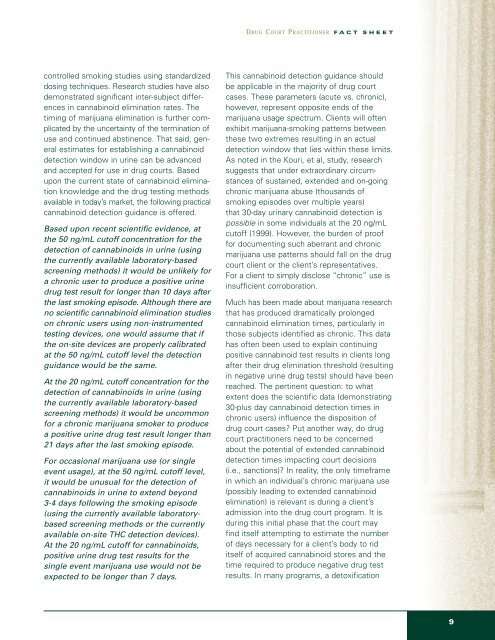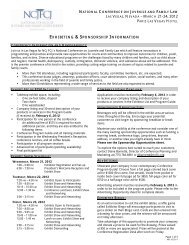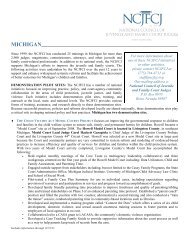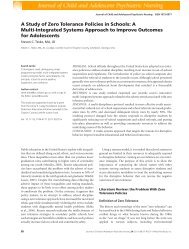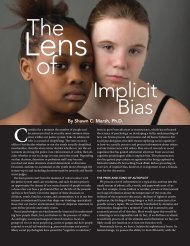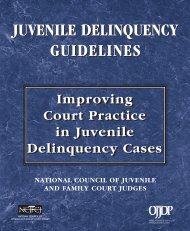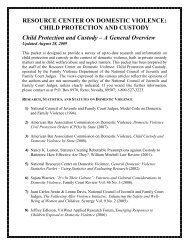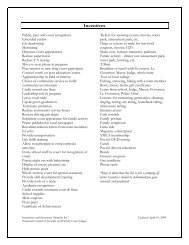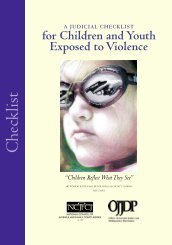The Marijuana Detection Window - National Drug Court Institute
The Marijuana Detection Window - National Drug Court Institute
The Marijuana Detection Window - National Drug Court Institute
- No tags were found...
Create successful ePaper yourself
Turn your PDF publications into a flip-book with our unique Google optimized e-Paper software.
DRUG COURT PRACTITIONER FACT SHEETcontrolled smoking studies using standardizeddosing techniques. Research studies have alsodemonstrated significant inter-subject differencesin cannabinoid elimination rates. <strong>The</strong>timing of marijuana elimination is further complicatedby the uncertainty of the termination ofuse and continued abstinence. That said, generalestimates for establishing a cannabinoiddetection window in urine can be advancedand accepted for use in drug courts. Basedupon the current state of cannabinoid eliminationknowledge and the drug testing methodsavailable in today’s market, the following practicalcannabinoid detection guidance is offered.Based upon recent scientific evidence, atthe 50 ng/mL cutoff concentration for thedetection of cannabinoids in urine (usingthe currently available laboratory-basedscreening methods) it would be unlikely fora chronic user to produce a positive urinedrug test result for longer than 10 days afterthe last smoking episode. Although there areno scientific cannabinoid elimination studieson chronic users using non-instrumentedtesting devices, one would assume that ifthe on-site devices are properly calibratedat the 50 ng/mL cutoff level the detectionguidance would be the same.At the 20 ng/mL cutoff concentration for thedetection of cannabinoids in urine (usingthe currently available laboratory-basedscreening methods) it would be uncommonfor a chronic marijuana smoker to producea positive urine drug test result longer than21 days after the last smoking episode.For occasional marijuana use (or singleevent usage), at the 50 ng/mL cutoff level,it would be unusual for the detection ofcannabinoids in urine to extend beyond3-4 days following the smoking episode(using the currently available laboratorybasedscreening methods or the currentlyavailable on-site THC detection devices).At the 20 ng/mL cutoff for cannabinoids,positive urine drug test results for thesingle event marijuana use would not beexpected to be longer than 7 days.This cannabinoid detection guidance shouldbe applicable in the majority of drug courtcases. <strong>The</strong>se parameters (acute vs. chronic),however, represent opposite ends of themarijuana usage spectrum. Clients will oftenexhibit marijuana-smoking patterns betweenthese two extremes resulting in an actualdetection window that lies within these limits.As noted in the Kouri, et al, study, researchsuggests that under extraordinary circumstancesof sustained, extended and on-goingchronic marijuana abuse (thousands ofsmoking episodes over multiple years)that 30-day urinary cannabinoid detection ispossible in some individuals at the 20 ng/mLcutoff (1999). However, the burden of prooffor documenting such aberrant and chronicmarijuana use patterns should fall on the drugcourt client or the client’s representatives.For a client to simply disclose “chronic” use isinsufficient corroboration.Much has been made about marijuana researchthat has produced dramatically prolongedcannabinoid elimination times, particularly inthose subjects identified as chronic. This datahas often been used to explain continuingpositive cannabinoid test results in clients longafter their drug elimination threshold (resultingin negative urine drug tests) should have beenreached. <strong>The</strong> pertinent question: to whatextent does the scientific data (demonstrating30-plus day cannabinoid detection times inchronic users) influence the disposition ofdrug court cases? Put another way, do drugcourt practitioners need to be concernedabout the potential of extended cannabinoiddetection times impacting court decisions(i.e., sanctions)? In reality, the only timeframein which an individual’s chronic marijuana use(possibly leading to extended cannabinoidelimination) is relevant is during a client’sadmission into the drug court program. It isduring this initial phase that the court mayfind itself attempting to estimate the numberof days necessary for a client’s body to riditself of acquired cannabinoid stores and thetime required to produce negative drug testresults. In many programs, a detoxification9


